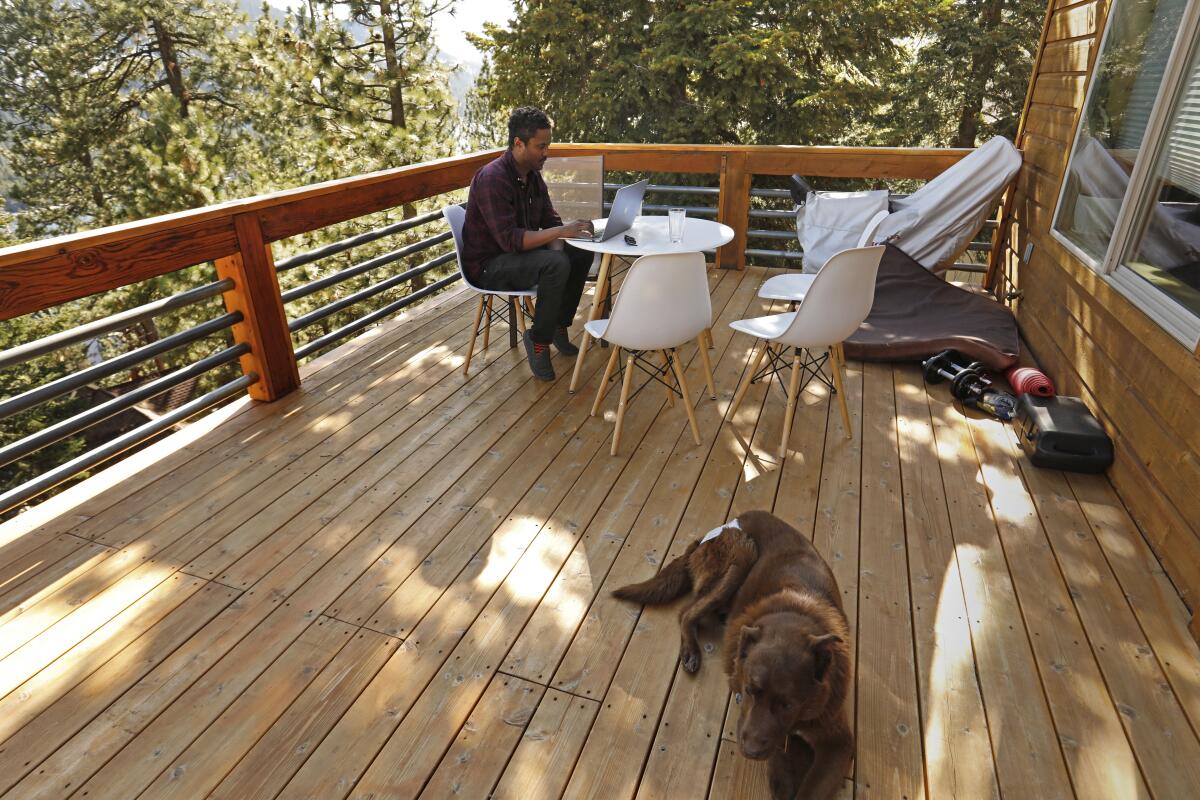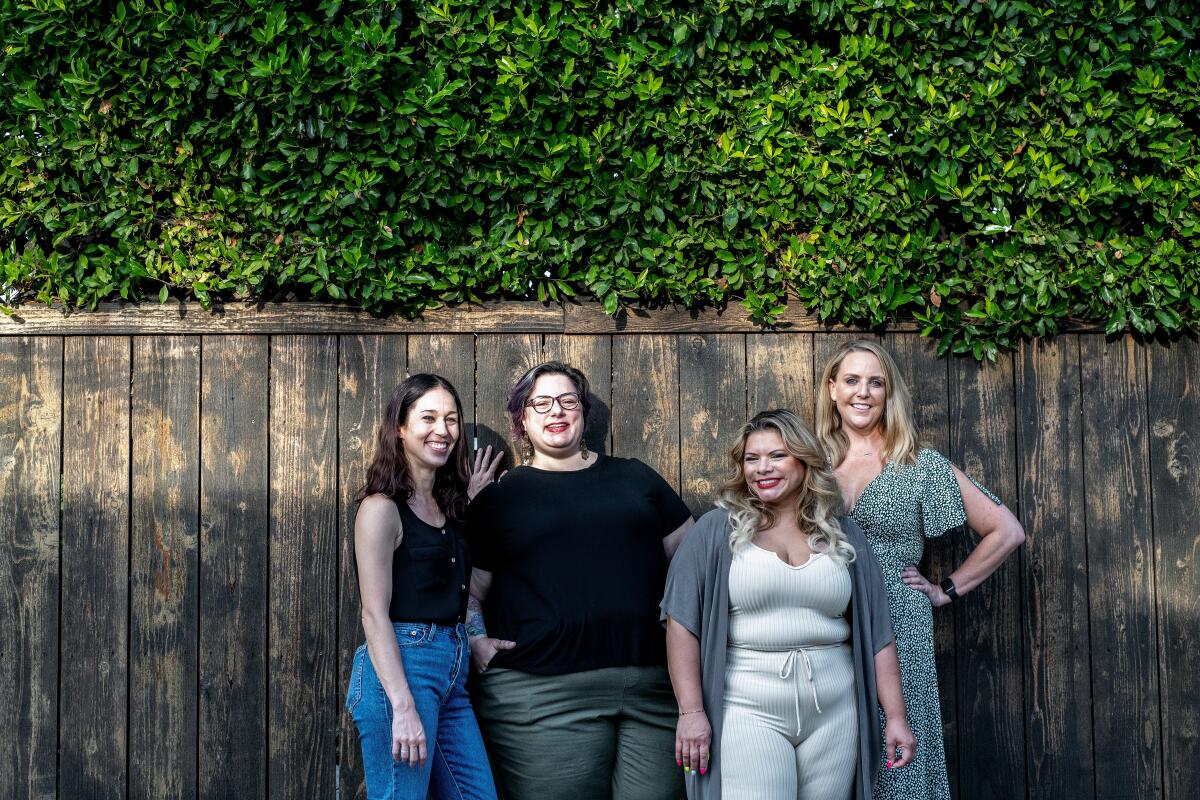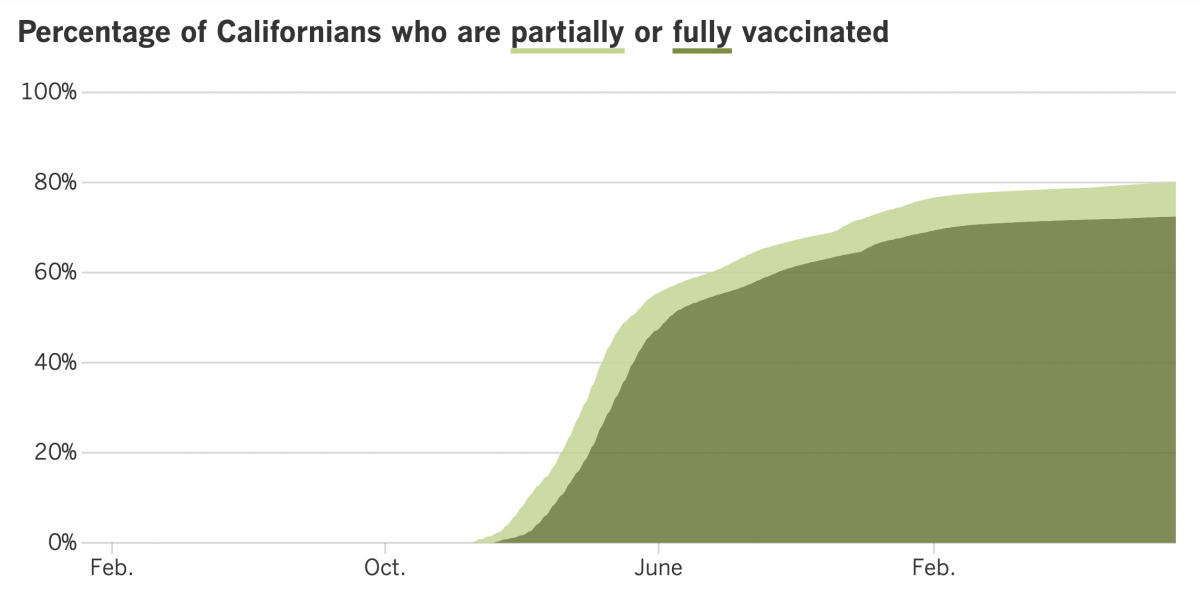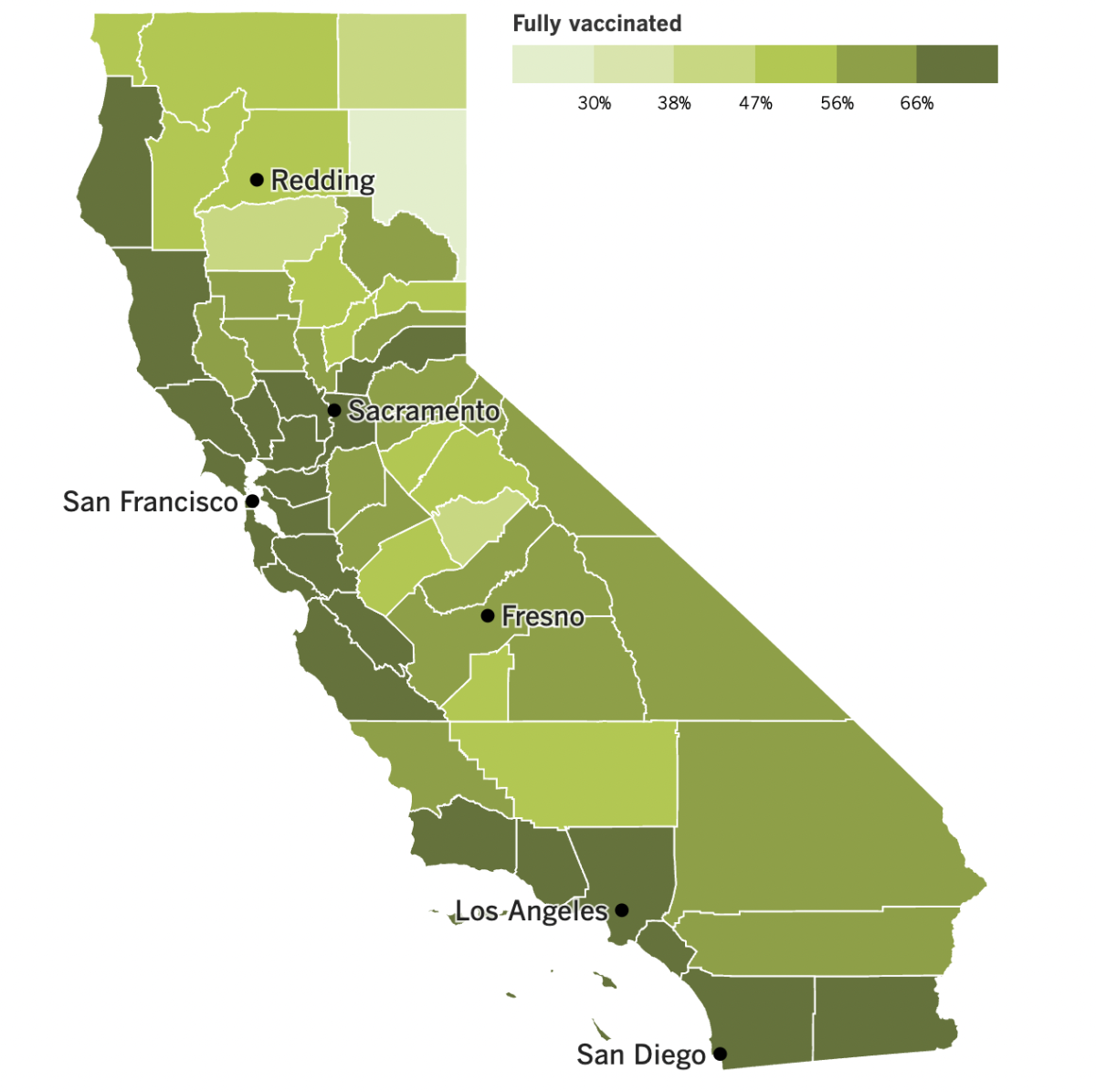Coronavirus Today: The cost of working from home
Good evening. I’m Karen Kaplan, and it’s Tuesday, Sept. 6. Here’s the latest on what’s happening with the coronavirus in California and beyond.
One of the unexpected upsides of the pandemic has been the ability to work from home. It’s not for everyone — it’s not even an option for everyone. But some lucky employees have been able to ditch their commutes and be more available to their families and friends while still getting their assignments done. By untethering their jobs from a specific geographic location, they’ve finally made strides in achieving that mythical state of “work-life balance.”
I’m fortunate to count myself among them. Maybe you do too. If so, I have some questions you might find unsettling:
How much is working from home worth to you? And would you be willing to pay to keep on doing it?
Tracey Parsons would. She’s a 46-year-old translator for the United Nations who’s been working from her home in the suburb of New Rochelle, N.Y., three days a week. (The two other days are spent at the U.N.’s offices in Manhattan.)
By cutting out three days of commuting, she figures she saves hundreds of dollars a month on train fare, lunches and other traditional expenses like dry cleaning. And if she could get rid of the two other days, the savings would multiply. That’s because it would allow her family to move farther away from New York City to a community with a lower cost of living and better prospects for her 8-year-old son, who has a disability.
If her bosses were OK with that, “I would definitely take a pay cut,” she told my colleague Don Lee before adding, “not that I think it would be fair.”
It’s definitely something worth thinking about. In fact, it’s already happening in other countries. A London-based law firm recently told its employees that if they wanted to work from home full time, they’d need to take a 20% pay cut.
Some employers in the U.S. are considering similar deals. A recent survey by the software and data firm Payscale found that 14% of employers here planned to reduce pay for workers who relocated to lower-cost places, and an additional 17% were considering it.
More broadly, the Working From Home Research Project reports that about 40% of employers planned to take advantage of remote work to ease pressure on their payrolls. That doesn’t necessarily mean cutting salaries, but some companies might keep costs down by hiring new workers in lower-cost parts of the country and paying them less than they’d earn at their headquarters.

A worker’s salary reflects many things — their years of experience, the number of people they manage, the time commitment needed to do their job well, and the cost of living where their office is. If a job happens to be in a high-cost city like New York or San Francisco, it stands to reason that it would pay more than the same job in Jackson, Miss., or Amarillo, Texas.
Now that the pandemic has prompted more workers to leave their locations but not their jobs, some companies — including tech giants like Google, Facebook and Twitter — have responded by adjusting salaries downward. But it doesn’t always go both ways.
Laura Sherbin, a managing director at the workplace research and consulting firm Seramount, told Lee about an employee who wanted to move from Washington to Georgia for personal reasons, and took a substantial pay cut to do so. Later, when the employee moved back to Washington, the company declined to reinstate his previous salary.
“What the company said to him was, ‘But, yeah, you could have stayed in Georgia. We’re not asking you to come back to the office,’” Sherbin said.
Maybe that’s unfair, or maybe the company has a point. Either way, more of us are likely to face dilemmas like this because the number of telecommuters is still way above pre-pandemic levels. According to the Working From Home Project, only 5% of paid workdays were being worked from remote locations in the days before COVID-19. Today, about 30% of them are.
Clearly, telecommuting has staying power because workers value it. A study by economists at the University of Chicago estimated that, when translated into dollars, it was worth as much as 7.3% of a worker’s earnings.
It’s valuable to employers too. In addition to saving money on salaries, companies are leasing less office space, maintaining fewer parking spaces, hiring smaller cleaning crews and buying less coffee for break rooms, among other expenses.
What remains to be seen is how those savings will be split between employers and their employees.
By the numbers
California cases and deaths as of 4:45 p.m. on Tuesday:

Track California’s coronavirus spread and vaccination efforts — including the latest numbers and how they break down — with our graphics.
Overcoming pandemic loneliness
The initial pandemic lockdowns were designed to isolate us from one another — and in some cases they worked too well.
With a menacing communicable disease on the loose, it made perfect sense to stay away from other people. But for some, that made the scariness and uncertainty of the pandemic’s early months even harder to bear.
It’s no surprise that Harvard researchers who set out to gauge the degree of emotional isolation in America found that 36% of us felt lonely “frequently, “almost all the time” or “all the time.” Even more alarming, the researchers reported, was that among young adults ages 18 to 25, the incidence of this “serious loneliness” was as high as 61%. Both figures were significantly higher than before the pandemic.
Serious loneliness can lead to serious health problems. It’s a contributor to heart disease, depression, anxiety, substance abuse and domestic abuse, among other conditions.
On top of that, let’s not forget that “being lonely frequently or all the time is simply a terrible way to live,” as the Harvard team put it.
Overcoming loneliness isn’t easy. That’s especially true in sprawling, car-centric Southern California, which often seems designed to keep us apart.
But it can be done. My colleague Lisa Boone shows us how with an array of success stories that just might inspire you to reach out to someone new.
My personal favorite features the residents of a small, multi-unit rental complex in Pasadena.

A few days before the lockdown, when the hoarding of toilet paper and other essentials was in full swing, the residents held a community meeting to talk through ways they could help one another if the city shut were to shut down. That meeting birthed a text messaging group that people used to request necessities like groceries or hand sanitizer. When someone needed something, someone else stepped up to provide it.
If a resident became sick with COVID-19, word spread via the messaging group and people offered assistance.
“Everyone shared resources they might have access to and how we could help each other stay safe,” said Danae Horst, owner of the Folia Collective plant store in Eagle Rock. “It was less about meeting our own needs and more about asking myself, ‘What can I do today to help others?’”
For some residents, that help was a lifeline.
“I was struggling and my neighbors literally kept me alive during the pandemic,” said Lauren Terschluse, a mental health therapist. “I was living in an apartment community where people were taking care of each other.... I knew that no matter what, there were people that I could lean on and I was never alone. We developed these friendships because of the pandemic.”
Fellow resident Cecilia Ramirez-Thomas directs a mental health agency. Being forced to work remotely made her feel alone and depressed, but the support of those around her helped her overcome those feelings.
“It became this comforting community of neighbors and the friendships blossomed,” Ramirez-Thomas said. “It was so nice to know that there was someone nearby and I wasn’t alone.”
The community helped its members through challenges beyond COVID-19 too. When Horst was diagnosed with ovarian cancer, fellow resident Amanda Timpson, a television producer, shared her washer and dryer so Horst and her husband didn’t have to schlepp to the laundromat. And when Terschluse broke her foot, members of the rental complex brought her groceries.
In some communities, neighbors spent the shutdown sniping about one another on the Nextdoor app. That’s the opposite of what happened in this Pasadena complex.
“The pandemic solidified the fact that we are all in this together,” Horst said.
California’s vaccination progress


See the latest on California’s vaccination progress with our tracker.
Your support helps us deliver the news that matters most.
In other news ...
The big news since our last edition is that the Centers for Disease Control and Prevention has recommended new versions of COVID-19 boosters that target the dominant Omicron strain in addition to the original version of the coronavirus. In fact, the CDC likes the “bivalent” boosters so much that the older ones, which don’t target BA.5 and its close cousin BA.4, are no longer available to most Americans.
The CDC recommended two versions of the new boosters. One, made by Moderna, is available to adults 18 and up. The other, made by Pfizer and BioNTech, can be given to people 12 and up.
Bivalent boosters for younger children are still in development and are expected to be available in the coming months. Until then, they can keep using the original booster. Everyone else will be switched to one of the new versions.
To be eligible for the new booster, you must meet a few criteria: You’ve finished your initial vaccination series. Your most recent dose — either a primary shot or a booster — was at least two months ago. You’re at least 12 years old. And you haven’t come down with a coronavirus infection in the last three months.
Public health officials have been touting the new shots as an essential component of a fall booster campaign. Modeling studies indicate why.
Researchers working with the COVID-19 Scenario Modeling Hub forecast that by making the new boosters available now — while BA.4 and BA.5 account for more than 91% of all SARS-CoV-2 coronaviruses in circulation — instead of waiting until November could prevent 137,000 hospitalizations and 9,700 deaths. And researchers at the Commonwealth Fund estimate that starting the booster drive in early fall could save $63 billion to $109 billion, mostly by reducing hospitalization costs.
Still, when the CDC’s vaccine advisory committee met Thursday to examine the new boosters and decide whether to recommend them, several members were hesitant to endorse them because they didn’t have data from human clinical trials, which are still ongoing.
“I understand we need better vaccines,” said Dr. Pablo Sanchez, a pediatric infectious-disease expert at Nationwide Children’s Hospital in Columbus, Ohio. “But I’m struggling with making a recommendation for a vaccine, a bivalent vaccine ... that has not been studied in humans.”
Others agreed that trial data would be reassuring, but ultimately decided that it wasn’t worth the wait since the pandemic is still causing tens of thousands of new infections and hundreds of deaths in the U.S. every day.
The Food and Drug Administration did not require clinical trial results before it authorized the updated booster shots Wednesday. The FDA had said new trials wouldn’t be necessary when all that was changing was the snippet of messenger RNA that tells cells how to construct a fake coronavirus spike protein that trains the immune system to recognize the real thing.
That’s not as risky as it may sound. Every year, the FDA and CDC approve updated versions of the flu shot that target the dominant strains of influenza without requiring elaborate clinical trials. Plus, the United Kingdom has been using a similar bivalent COVID-19 booster that targets the original Omicron strain, and regulators there have found no safety issues with it.
The original boosters are still preventing serious illnesses and deaths, but the hope is that the new targeted boosters will be more effective at reducing infections. The shots deployed in the U.K. offer reason to think so: Pfizer and Moderna said they prompted recipients to produce more Omicron-fighting antibodies than the original boosters did.
In other vaccine news, a bill that would have allowed California minors to consent to vaccines without their parents’ permission will not become law, at least not this year. The bill’s sponsor, state Sen. Scott Wiener (D-San Francisco), said he withdrew the measure because it was “several votes short” of the 41 needed to pass on the last day of the legislative session.
The vaccine consent bill was one of several aimed at improving vaccination rates in the state and reducing misinformation about COVID-19. Had it passed, teens who were at least 15 years old would have been able to consent to any vaccine on their own, without having to inform their parents. The initial version would have made 12 the age of consent, but Wiener raised it to 15 to make it more palatable in the state Assembly.
“SB 866 did nothing more than empower young people to protect their own health, even if their parents have been brainwashed by anti-vax propaganda or are abusive or neglectful,” Wiener said of his ill-fated bill. But opponents argued that it interfered with a parent’s right to choose what’s best for their child.
In Los Angeles, the head of a community health center has apologized for giving roughly 2,100 people diluted doses of vaccine last year at its clinics in Boyle Heights and Westlake. Carlos Vaquerano, chief executive of Clínica Romero, said the shots were administered in September and October, but the organization didn’t learn of the problem until May.
The mix-up appears to have been unintentional. A staff member was diluting doses of the Pfizer-BioNTech vaccine when doing so was no longer required. The people who got the under-dosed shots were contacted so they could get new injections.
“At this point, we haven’t had any patients with any problems,” Vaquerano said. “We understand their concern and I apologize for what happened.”
The reading and math tests known as the “nation’s report card” have revealed alarming trends about the extent of students’ learning loss during the pandemic.
For 9-year-olds, the average math score on the National Assessment of Educational Progress fell 7 points to 235 on a 0-500 scale. It was the first time the average math score had fallen since the test was introduced in the 1970s. The average reading score fell 5 points to 215 — the largest decline in 30 years.
And it gets worse: The biggest drops were seen amongstudents who were already struggling. In math, scores for students in the top 10% fell 3 points, while those in the bottom 10% dropped 12 points. In reading, the top 10% of test takers lost 2 points but those in the bottom 10% lost 10 points.
“There has been a truly historic decrease in performance,” said Los Angeles Unified Supt. Alberto Carvalho, who sits on the governing board for the tests. The nationwide trends will be reflected in local test scores, he said.
And finally, it might be tempting to think that the end of the pandemic is finally near, but scientists say we still have a ways to go.
Even if the new booster shot works like a charm and no new variants come along, experts still predict that the U.S. will see more than 650,000 hospitalizations and 111,000 deaths between August and May 2023. If a new variant does emerge and it takes a while for people to get their booster shots, the country could be looking at as many as 1.3 million hospitalizations and 181,000 deaths over the same period.
Until more effective, longer-lasting vaccines are developed and — critically — deployed equitably around the world, the coronavirus will keep evolving new variants that cause new surges, said Dr. Eric Topol, head of Scripps Research Translational Institute. For now, he said, the virus “just has too many ways to work around our current strategies, and it’ll just keep finding people, finding them again, and self-perpetuating.”
Your questions answered
Today’s question comes from readers who want to know: How soon can I get the new COVID-19 booster?
You can get it right away! At least one pharmacy in Los Angeles said it began offering the shots on Friday, a day before the Western States Scientific Safety Review Workgroup officially endorsed them. (That sign-off is the last regulatory step in California and is supposed to occur before a new vaccine is made available.)
Some pharmacies and healthcare providers are already booking appointments online, including CVS, Walgreens, Rite Aid and Kaiser Permanente. At last check, some next-day time slots were still available. The shots are free, but be sure to have your health insurance information handy when you make your appointment. You’ll also be asked for the date of your most recent dose, whether it was from your primary series or a booster.
The L.A. County Department of Public Health plans to join the fray very soon. The new bivalent boosters are expected to be available through the health department starting Wednesday, according to the agency’s COVID-19 vaccine website. Those who’d rather make an appointment by phone can call the department at (833) 540-0473.
To be eligible for the new booster, you must be at least 12 years old, have finished your primary vaccination series, and gone at least two months since your last dose. If you’ve had a coronavirus infection recently, the CDC recommends that you wait until three months have passed since you first tested positive or you experienced your initial COVID-19 symptoms.
We want to hear from you. Email us your coronavirus questions, and we’ll do our best to answer them. Wondering if your question’s already been answered? Check out our archive here.
The pandemic in pictures

These little glass vials contain the new COVID-19 booster shots. In the photo above, they’re making their way along a production line at Pfizer’s 1,300-acre manufacturing facility in Kalamazoo, Mich., and don’t have labels affixed to them yet.
The CDC’s vaccine advisors were quite concerned about the labels — in particular, making sure the new boosters wouldn’t be confused with the original ones. The bivalent booster is expected to be much more effective against Omicron, and the panel members were eager to minimize the risk that someone would get the old version by accident.
Resources
Need a vaccine? Here’s where to go: City of Los Angeles | Los Angeles County | Kern County | Orange County | Riverside County | San Bernardino County | San Diego County | San Luis Obispo County | Santa Barbara County | Ventura County
Practice social distancing using these tips, and wear a mask or two.
Watch for symptoms such as fever, cough, shortness of breath, chills, shaking with chills, muscle pain, headache, sore throat and loss of taste or smell. Here’s what to look for and when.
Need to get a test? Testing in California is free, and you can find a site online or call (833) 422-4255.
Americans are hurting in various ways. We have advice for helping kids cope, as well as resources for people experiencing domestic abuse.
We’ve answered hundreds of readers’ questions. Explore them in our archive here.
For our most up-to-date coverage, visit our homepage and our Health section, get our breaking news alerts, and follow us on Twitter and Instagram.




